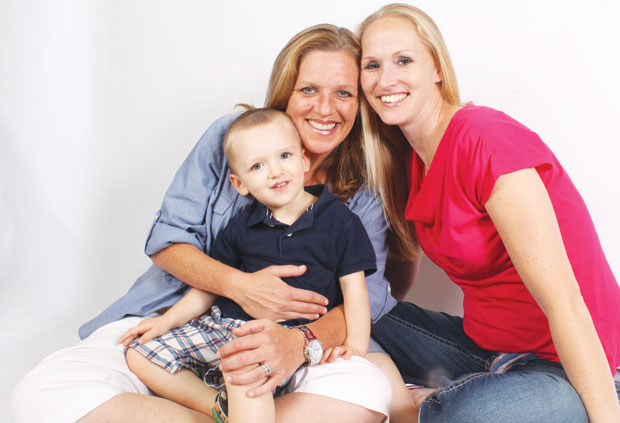What does it take for a lesbian couple to start a family? Patty and Carrie Breckenridge found out the hard way

AND BABY MAKES 4 | Patty, Logan and Carrie Breckenridge … and little Charlotte, cooking away for her Nov. 11 debut. (Arnold Wayne Jones/Dallas Voice)
ARNOLD WAYNE JONES | Life+Style Editor
A lot of people don’t know what they will be doing day after tomorrow, but for at least three months, Carrie and Patty Breckenridge have known what they would be doing on Nov. 11, 2013: Welcoming their new daughter into the world.
At least, they hope so.
But for the Breckenridges, a day or three in either direction hardly matters. What’s important is that they continue to build their family.
For gay and lesbian couples, having children isn’t as easy as a drunken night at a wedding reception or a broken condom. It requires planning and thought and a lot of money. And there can be heartbreak throughout the process.
For Carrie and Patty, the “process” dates back to the summer of 2007. That’s when they first met. It wasn’t love at first sight — at least not for both of them.
“I told her, you’re either gonna date me or I’m gonna give you some space [until you do],” Patty recalls. It took a few months, but Carrie eventually came around. In February 2009, they exchanged vows in a ceremony near Lake Lewisville. But that was just the beginning of the family.
“Ever since I was younger, I always knew I wanted to be the supporter — I never wanted to [carry a child]. And Carrie was born to carry — she was even given the right name,” Patty says.
“We starting trying to have a baby within a month [of the wedding],” Carrie says.
Still, it took well more than a month for them to get pregnant.
They went to a reproductive endocrinologist, who broke the news: “I have bad eggs,” Carrie says, jokingly adding, “like little Cadbury eggs.”
“They come out as bunnies,” Patty quickly quips.
At 34, she had the eggs of a 40-year-old. A normal test level for someone her age was 1.5; she was at 0.22.
But the couple didn’t give up hope.
Their first decision was who to get as a sperm donor.
“We’ve got friends who used a friend as the donor, and they are very engaged in the children‘s lives … “ Patty begins, “… and that is not OK with me,” Carrie finishes.
“We are the parents,” adds Patty. That meant a sperm bank.
The donor selection process itself they describe as “like picking out a car — what color do you want the hair and eyes,” Carrie says. But there was so much more to it than that.
“We knew we wanted blond hair and blue eyes [to match their mothers], but we wanted personality traits of [Carrie]. You can see kindergarten pictures of the donors,” Patty explains.
They eventually narrowed their choices to one of four donors. They “upgraded” their package where they can hear the donors speak and even get staff impressions of them.
It took 14 months and eight rounds of interuterine insemination (IUI) before they could conceive, but conceive they did. Logan Nicholas Breckenridge was born almost exactly two years after their wedding. But they weren’t done yet making a family.
“When Logan was six months old, we started trying again,” Carrie explains. Because of her low quality eggs, it was “now or never.”
They did two more rounds of IUI, but without luck. They were running out of options — and time.
Because they wanted any children to be full siblings, they were constrained by the amount of sperm they had access to: they’d bought 10 vials and were running out. “That was our last shot,” Carrie says.
So the Breckenridges took a big step: they switched over to in vitro fertilization (IVF). And they did something more: They promised everyone not only would they get pregnant this time, but it would be a girl.
And in less than two months, Charlotte Campbell Breckenridge will join their clan.
It took a lot of time and money to make their nuclear family, which has in some ways focused the Breckenridges’ stance on social change.
“I’m not a political person,” says Patty, “but it literally hurts my heart that people stand so strong and make it so hard on gay couples — who can be well off and want nothing more than to give this child the best life possible — by creating so many restrictions.”
“To decide to have a family takes a lot of planning,” says Carrie. “It’s a time commitment, it’s financial. To take all the medicine I had to take, emotionally and physically, it wears on you. After negative result after negative result, you think ‘What am I doing wrong?’”
And carrying a child (throughout a Texas summer) while also rearing a 2-year-old is its own kind of hellish challenge.
“No one can prepare a mother who is nursing about how tired I would be,” Carrie says. “I had no idea what ‘tired’ meant until now. Still, it gets better. It does get better.”
And that’s a message all gay people can relate to.
This article appeared in the Dallas Voice print edition September 27, 2013.

